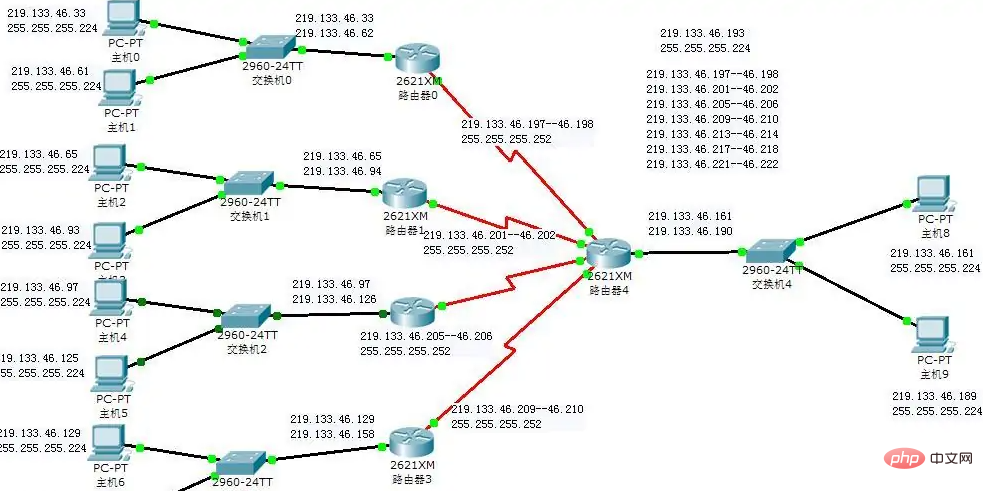
The default subnet mask for Class A networks is "255.0.0.0"; a subnet can accommodate up to 16.77 million computers. The subnet mask is also called a network mask and an address mask. A bit mask used to indicate which bits of an IP address identify the subnet where the host is located, and which bits identify the host.

The operating environment of this tutorial: Windows 10 system, DELL G3 computer.
The default subnet mask for a Class A network is 255.0.0.0. One subnet can have up to Accommodates more than 16.77 million computers. The default subnet mask of Class B is 255.255.0.0, and one subnet can accommodate up to 60,000 computers; the default subnet mask of Class C is 255.255.255.0, and one subnet can accommodate up to 254 computers.
Subnet mask is also called network mask, address mask, and subnet mask. It is a method used to indicate which bits of an IP address identify the subnet where the host is located. , and which bits identify the host's bit mask. The subnet mask cannot exist alone, it must be used in conjunction with the IP address. The subnet mask has only one function, which is to divide an IP address into two parts: the network address and the host address.
The subnet mask is a 32-bit address that is used to mask a part of the IP address to distinguish the network identification and the host identification, and to indicate whether the IP address is on a local area network or a remote network.

Extended knowledge
The subnet mask was created to solve the problem of IP address allocation in the context of the shortage of IPv4 address resources. Virtual IP technology divides the three types of addresses A, B, and C into several subnets through subnet masks, thereby significantly improving the efficiency of IP address allocation and effectively solving the shortage of IP address resources. On the other hand, in order to better manage the network in an enterprise's intranet, network administrators also use subnet masks to artificially divide a larger enterprise's internal network into more small-scale subnets, and then use The routing function of the three-layer switch realizes subnet interconnection, thereby effectively solving many network management problems such as network broadcast storms and network viruses.
In most network textbooks, the function of the subnet mask is generally described as dividing the IP address into a network identification (Net.ID) and a host identification (Host.ID) through logical operations. Only two hosts with the same network ID can communicate with each other without routing.
According to the definition of RFC950, a subnet mask is a 32-bit binary number in which all bits corresponding to the network address are set to 1 and all bits corresponding to the host address are set to 0. The subnet mask tells the router which part of the address is the network address and which part is the host address, allowing the router to correctly determine whether any IP address belongs to this network segment and thus perform routing correctly. On the network, data is transmitted from one place to another relying on IP addressing. Logically speaking, it is a two-step process. The first step is to find the network to which the host belongs from the IP, which is like finding which community this person belongs to; the second step is to find the location of the host in the network from the IP, which is like finding the person in the community.
The setting of subnet mask must follow certain rules. Like the binary IP address, the subnet mask consists of 1 and 0, and the 1 and 0 are consecutive. The length of the subnet mask is also 32 bits. The left side is the network bits, represented by the binary number "1", the number of 1s is equal to the length of the network bits; the right side is the host bits, represented by the binary number "0", the number of 0s is equal to the host bit length. The purpose of this is to use 0 to cover the original host number when performing a bitwise AND operation between the mask and the IP address without changing the original network segment number, and it is easy to determine the number of hosts in the subnet through the number of 0 bits (2 The host number is raised to the power of -2, because when the host number is all 1, it represents the broadcast address of the network, and when it is all 0, it represents the network number of the network. These are two special addresses). The subnet mask can indicate the relationship between the subnet where a host is located and other subnets, so that the network can work normally.
For more related knowledge, please visit the FAQ column!
The above is the detailed content of What is the default subnet mask for a Class A network?. For more information, please follow other related articles on the PHP Chinese website!